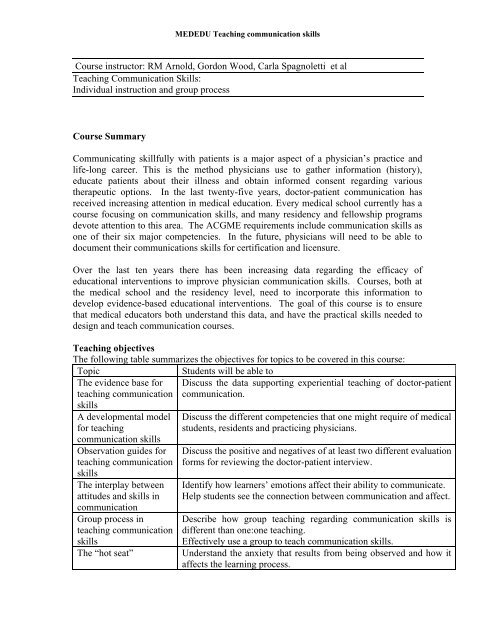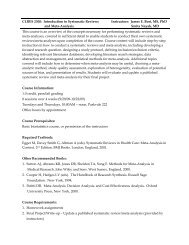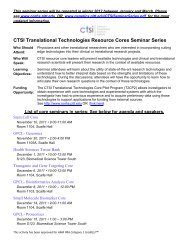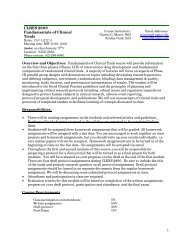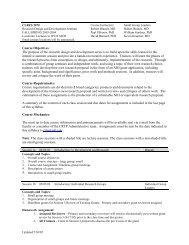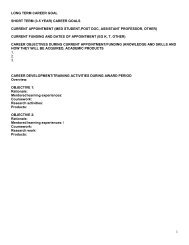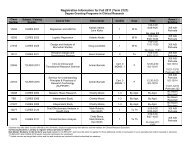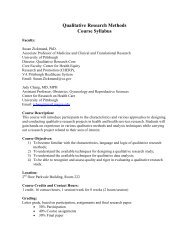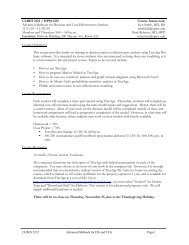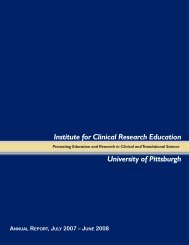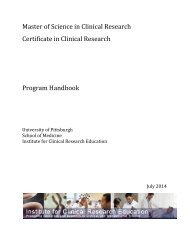Course instructor: RM Arnold, Gordon Wood, Carla Spagnoletti et al ...
Course instructor: RM Arnold, Gordon Wood, Carla Spagnoletti et al ...
Course instructor: RM Arnold, Gordon Wood, Carla Spagnoletti et al ...
- No tags were found...
You also want an ePaper? Increase the reach of your titles
YUMPU automatically turns print PDFs into web optimized ePapers that Google loves.
MEDEDU Teaching communication skills<strong>Course</strong> <strong>instructor</strong>: <strong>RM</strong> <strong>Arnold</strong>, <strong>Gordon</strong> <strong>Wood</strong>, <strong>Carla</strong> <strong>Spagnol<strong>et</strong>ti</strong> <strong>et</strong> <strong>al</strong>Teaching Communication Skills:Individu<strong>al</strong> instruction and group process<strong>Course</strong> SummaryCommunicating skillfully with patients is a major aspect of a physician’s practice andlife-long career. This is the m<strong>et</strong>hod physicians use to gather information (history),educate patients about their illness and obtain informed consent regarding varioustherapeutic options. In the last twenty-five years, doctor-patient communication hasreceived increasing attention in medic<strong>al</strong> education. Every medic<strong>al</strong> school currently has acourse focusing on communication skills, and many residency and fellowship programsdevote attention to this area. The ACGME requirements include communication skills asone of their six major comp<strong>et</strong>encies. In the future, physicians will need to be able todocument their communications skills for certification and licensure.Over the last ten years there has been increasing data regarding the efficacy ofeducation<strong>al</strong> interventions to improve physician communication skills. <strong>Course</strong>s, both atthe medic<strong>al</strong> school and the residency level, need to incorporate this information todevelop evidence-based education<strong>al</strong> interventions. The go<strong>al</strong> of this course is to ensur<strong>et</strong>hat medic<strong>al</strong> educators both understand this data, and have the practic<strong>al</strong> skills needed todesign and teach communication courses.Teaching objectivesThe following table summarizes the objectives for topics to be covered in this course:TopicStudents will be able toThe evidence base for Discuss the data supporting experienti<strong>al</strong> teaching of doctor-patientteaching communication communication.skillsA development<strong>al</strong> modelfor teachingcommunication skillsObservation guides forteaching communicationskillsThe interplay b<strong>et</strong>weenattitudes and skills incommunicationGroup process inteaching communicationskillsThe “hot seat”Discuss the different comp<strong>et</strong>encies that one might require of medic<strong>al</strong>students, residents and practicing physicians.Discuss the positive and negatives of at least two different ev<strong>al</strong>uationforms for reviewing the doctor-patient interview.Identify how learners’ emotions affect their ability to communicate.Help students see the connection b<strong>et</strong>ween communication and affect.Describe how group teaching regarding communication skills isdifferent than one:one teaching.Effectively use a group to teach communication skills.Understand the anxi<strong>et</strong>y that results from being observed and how itaffects the learning process.
MEDEDU Teaching communication skillsFeedbackVideo-reviewRole-playingStandardized patientsOSCEClinic<strong>al</strong> teachingPar<strong>al</strong>lel processLife-long learningProvide learner-centered feedback.Describe three models of providing feedback.Describe the advantages and disadvantages of this teaching m<strong>et</strong>hod.Effectively use this m<strong>et</strong>hod when teaching doctor-patientcommunication.Describe the advantages and disadvantages of this teaching m<strong>et</strong>hod.Effectively use this m<strong>et</strong>hod to teach doctor-patient communication.Describe the advantages and disadvantages of this teaching m<strong>et</strong>hod.Effectively use this m<strong>et</strong>hod when teaching doctor patientcommunication.Describe the advantages and disadvantages of this ev<strong>al</strong>uation m<strong>et</strong>hodDevelop an OSCE.Describe a three step process for teaching in the clinic<strong>al</strong> s<strong>et</strong>ting.Describe how to ascertain a learner’s go<strong>al</strong>s prior to watching themt<strong>al</strong>k to patients.Describe how you will d<strong>et</strong>ermine when to intervene when watchinga learner t<strong>al</strong>k to a patient.Describe how to give feedback to a learner after watching them t<strong>al</strong>kto a patient.Describe how to debrief your communication skills after rolemodeling a communication encounter.Be able to describe the relationship b<strong>et</strong>ween teaching and doctorpatientinterviewing.Be able to identify how issues in teaching are played out in thestudent-patient encounter.Describe how you will take the skills you have learned during theclass and practice them in the future.<strong>Course</strong> mechanics:2 credits2 sessions per week 10/25-12/15 (maybe a session on 12/20)Monday and Wednesday from 1:15-4:30 (will end b<strong>et</strong>ween 4-5)Most sessions will cover specific teaching skills. While we may t<strong>al</strong>k about aspecific part of the encounter, the focus is on teaching rather than the content ofthe encounter.No more than 1:8 faculty: student ratio (typic<strong>al</strong>ly will be 1:4)Will use a simulated patient for sessions; video review and role play.<strong>Course</strong> type:Mini-Lecture, discussion, demonstration, question and answerStrong emphasis on inter-active teaching and role-playingGrading: Pass/FailClass participation 75 %
MEDEDU Teaching communication skillsTeacher skill ev<strong>al</strong>uation 25%Location:Parkv<strong>al</strong>e Building, Room 219Prerequisites:NoneTextKurtz S, Silverman J, Draper J. Teaching and learning communication skills inmedicine. Radcliffe Medic<strong>al</strong> Press. 2 nd ed 2005
MEDEDU Teaching communication skillsClass sessionsSession 1 Bob <strong>Arnold</strong> 10/25 3-430A ration<strong>al</strong>e for communication skills teachingDefining what one wants to teach in communication skills:Defining go<strong>al</strong>s in a development<strong>al</strong> curriculumBy the end of this session, participants will:1. Define the appropriate role of lecture, discussion and experienti<strong>al</strong> learning m<strong>et</strong>hods toteach communication2. Understand the positive and negative aspects of using practice interviews.3. Be able to describe three models for conceptu<strong>al</strong>izing teaching the doctor-patientinterview4. Be able to differentiate b<strong>et</strong>ween medic<strong>al</strong> student, resident and practicing physicianskills.Readings:Required Readings:Kurtz S, Silverman J, Draper J. Teaching and learning communication skills in medicine.Radcliffe Medic<strong>al</strong> Press. 2 nd ed 2005, chapter 1-2 and 4.Fellowes, D., S. Wilkinson, and P. Moore, Communication skills training for he<strong>al</strong>th careprofession<strong>al</strong>s working with cancer patients, their families and/or carers. Cochrane Database SystRev, 2004(2): p. CD003751.Handouts from Bill Cohen/L Milberg’s First year medic<strong>al</strong> student communication coursefor the faculty.Recommended Readings:Carroll, JG, Lipkin M, Nachtig<strong>al</strong>l L, Weston, WW. A development<strong>al</strong> awareness forteaching doctor-patient communication skills In . In Lipkin M, Putnam SM, Lazarre A(Eds.), The Medic<strong>al</strong> Interview, New York: Springer.1995: 388-96.Skeff, KM, Stratos, GA, Berman, J. Education<strong>al</strong> theory and teaching medic<strong>al</strong>Interviewing. In Lipkin M, Putnam SM, Lazarre A (Eds.), The Medic<strong>al</strong> Interview, NewYork: Springer.1995: 379-387.Assignment for the session (we will do in the session): Compl<strong>et</strong>e the Rezler-Canfieldlearning preference inventory she<strong>et</strong> and score
MEDEDU Teaching communication skillsTeaching m<strong>et</strong>hod:Seminar discussionI. <strong>Course</strong> introductiona. Go<strong>al</strong>sb. Structurec. Expectationi. Their learning go<strong>al</strong>sd. GradingII. Importance of doctor-patient communicationIII.IV.V.Is doctor-patient communication teachable – Review of the dataDifferent m<strong>et</strong>hods of teaching doctor-patient communicationa. Education<strong>al</strong> theoryb. Par<strong>al</strong>lel processc. What are we trying to do?Group exercises:I. One-page go<strong>al</strong>s for 1 st /3 rd year students and interns focusing on theircomp<strong>et</strong>ency in the first ten minutes of the interview.II. Discussion of differencesa. Readinessi. Cognitivelyii. Emotion<strong>al</strong>lyb. Teaching opportunitiesc. Ide<strong>al</strong>s vs. minimumIII. Characteristics of good teachinga. Does it differ for doctor-patient communicationi. Whyii. Role of identity and affectDemonstration
MEDEDU Teaching communication skillsSession 2 Bob <strong>Arnold</strong>, <strong>Gordon</strong> <strong>Wood</strong>, <strong>Carla</strong> <strong>Spagnol<strong>et</strong>ti</strong> and Dem<strong>et</strong>ria Marsh Oct 27Teaching using standardized patients – Part I- Learning the experiment<strong>al</strong>learning m<strong>et</strong>hod; starting classBy the end of this session, participants will:1. Be able to s<strong>et</strong> up practice interviews in a group learning s<strong>et</strong>ting.2. Be able to provide the instructions prior to starting the role playing3. Be able to recognize common “mis-steps” in the start of an interviewRequired Readings (These readings are for sessions on Nov 4,9,11,16,23,30):Kurtz S, Silverman J, Draper J. Teaching and learning communication skills in medicine.Radcliffe Medic<strong>al</strong> Press. . 2 nd ed 2005, chapter 3, 5-8Edwards-Fryer K, <strong>Arnold</strong> <strong>RM</strong>, Baile W, Tulsky JA, P<strong>et</strong>racca F, Back A. Teachingcommunication skills: A Qu<strong>al</strong>itative study of reflective teaching practices. AcademicMedicine 2006: 81: 638-44. (One group’s experience of teaching using simulatedpatients)Handouts from Oncot<strong>al</strong>k Teach (c<strong>al</strong>led MSSM facilitator, essenti<strong>al</strong>)Handout from William Cohen and L Milberg on primary teaching m<strong>et</strong>hod (summaryPTM)Teaching m<strong>et</strong>hod:Seminar discussionDemonstrationGroup exercises
MEDEDU Teaching communication skillsSession 3 Nov 1<strong>Gordon</strong> <strong>Wood</strong>, <strong>Carla</strong> <strong>Spagnol<strong>et</strong>ti</strong>, Bob <strong>Arnold</strong> and Dem<strong>et</strong>ria MarshWhat to do when the learner "times out": Feedback and using the groupBy the end of this session, participants will:1. Be able to debrief a session when a learner times out2. Be able to define effective feedback3. Be able to describe learner-centered feedback and how it differs from a “feedbacksandwich”4. Be able to obtain feedback from the learner and the group5. Be able to d<strong>et</strong>ermine what issues to focus on during a time out (learner-centeredfeedback)Required Readings:Ende, J. Feedback in clinic<strong>al</strong> medic<strong>al</strong> education. JAMA. 1983:250: 777-781.See aboveTeaching m<strong>et</strong>hod:Seminar discussionDemonstrationGroup exercises
MEDEDU Teaching communication skillsSession 4 Nov 3<strong>Gordon</strong> <strong>Wood</strong>, <strong>Carla</strong> <strong>Spagnol<strong>et</strong>ti</strong> Dem<strong>et</strong>ria Marsh, and Bob <strong>Arnold</strong>Teaching using standardized patients –More onfeedback, redo and take home pointsBy the end of this session, participants will:1. Be able to help the learner come up with solutions about their problems2. Be able to redo the part of the interview where the learner is stuck3. Be able to use the SP to give feedback4. Be able to help the learner define a take home pointRequired Readings:See above
MEDEDU Teaching communication skillsSession 5 Nov 8<strong>Gordon</strong> <strong>Wood</strong>, <strong>Carla</strong> <strong>Spagnol<strong>et</strong>ti</strong>, Bob <strong>Arnold</strong>, Dem<strong>et</strong>ria MarshDe<strong>al</strong>ing with learner emotions as a reason for timing outBy the end of this session, participants will:1. Be able to highlight affective issues during practice with simulated patients2. Be able attend to the learner’s emotion<strong>al</strong> reaction to the patient encounterRequired Readings:See above
MEDEDU Teaching communication skillsSession 6 – November 10Bob <strong>Arnold</strong>, <strong>Gordon</strong> <strong>Wood</strong>, <strong>Carla</strong> <strong>Spagnol<strong>et</strong>ti</strong>, Dem<strong>et</strong>ria MarshMore practice and developing and training simulated patientsBy the end of this session, participants will:1. Be able to describe the positives and negatives of using simulated patients2. Be able to describe simulated patient trainingRequired Readings:Barrows HS. An overview of the uses of standardized patients for teaching andev<strong>al</strong>uating clinic<strong>al</strong> skills. Acad Med. 1993;68(6);443-453.Examples of standardized patient scripts Laurael Milberg, Robert <strong>Arnold</strong>Training manu<strong>al</strong>s for standardized patient Dem<strong>et</strong>ria Marsh
MEDEDU Teaching communication skillsSession 7– November 15Bob <strong>Arnold</strong>, <strong>Gordon</strong> <strong>Wood</strong>, <strong>Carla</strong> <strong>Spagnol<strong>et</strong>ti</strong>, Dem<strong>et</strong>ria MarshFaculty time outBy the end of this session, participants will:1. Be able to describe the positives and negatives of using simulated patients2. Be able to describe simulated patient trainingRequired Readings:
MEDEDU Teaching communication skillsSession 8 – November 17Bob <strong>Arnold</strong>, <strong>Gordon</strong> <strong>Wood</strong>, <strong>Carla</strong> <strong>Spagnol<strong>et</strong>ti</strong>, Dem<strong>et</strong>ri MarshOpen practice of simulated patient teaching m<strong>et</strong>hod
MEDEDU Teaching communication skillsSession 9 – November 22<strong>Gordon</strong> <strong>Wood</strong>, <strong>Carla</strong> <strong>Spagnol<strong>et</strong>ti</strong>Teaching communication using video reviewGo<strong>al</strong>s:By the end of this session, participants will:1. Understand the role of videotape review in assessing and teachingcommunication skills.2. Appreciate the capacity of the videotape to develop learner’s capacity to beself-reflective.3. Use videotape to improve and enhance feedback to learners about theircommunication skills.Objectives:1. Define positive and negative features of using videotape review forteaching communication skills2. Identify videotape triggers that facilitate reflection on communicationskills3. Recognize non-verb<strong>al</strong> behaviors during videotape review and describe howthey affect communication4. Practice giving feedback to learners using specific videotape-observedbehaviorsReadings:Recommended:"Teaching creatively with video: fostering reflection, communication and other clinic<strong>al</strong>skills”. by Jane Westberg and Hilliard Jason from the Springer series on medic<strong>al</strong>education. Best chapters are 2, 3, 6, 7.Beckman HB. Frankel <strong>RM</strong>. The use of videotape in intern<strong>al</strong> medicine training. Journ<strong>al</strong> ofGener<strong>al</strong> Intern<strong>al</strong> Medicine. 9(9):517-21, 1994 Sep
MEDEDU Teaching communication skillsSession 10 Nov 29Bob <strong>Arnold</strong>, <strong>Gordon</strong> <strong>Wood</strong>, <strong>Carla</strong> <strong>Spagnol<strong>et</strong>ti</strong>Teaching communication in conferences and actu<strong>al</strong> patient encounters: Part 1 A threestep m<strong>et</strong>hod for teaching communication in a clinic<strong>al</strong> s<strong>et</strong>tingBy the end of this session, participants will:1) Be able to discuss go<strong>al</strong>s with a learner prior to watching a learner interact with apatient2) Be able to d<strong>et</strong>ermine when you will intervene when watching a learner interactwith a patient.3) Be able to give a learner feedback after watching the learner interact with apatient4) Be able to debrief after you have role modeled an interaction with a patientReadings Required:Oncot<strong>al</strong>k Teach Modules. Back T, <strong>Arnold</strong> <strong>RM</strong>, Fryer-Edwards K, Baile W, Tulsky J.Back AL, <strong>Arnold</strong> <strong>RM</strong>, Tulsky JA, B<strong>al</strong>e WF, Edwards K. Could I Add Som<strong>et</strong>hing?":Teaching Communication by Intervening in Re<strong>al</strong> Time During a Clinic<strong>al</strong> Encounter.Acad Med. 2010: 85: (6): 1048-1051.Suggested readingsKurtz S, Silverman J, Draper J. Teaching and learning communication skills in medicine.Radcliffe Medic<strong>al</strong> Press. . 2 nd ed 2005, chapter 9,12
MEDEDU Teaching communication skillsSession 11 – Dec 1<strong>Gordon</strong> <strong>Wood</strong>, <strong>Carla</strong> <strong>Spagnol<strong>et</strong>ti</strong>, Gary Fischer, Bob <strong>Arnold</strong>Teaching communication in conferences and actu<strong>al</strong> patient encounters II. Role play liteand when learners bring communication problems to the facultyBy the end of this session, participants will:1) Be able to integrate short role-plays into attending rounds or noon conference2) Be able to describe the positives and negatives of role play lite3) Be able to describe the positive and negatives of using students to be the “patient”in a role playReadings Required:Cohen-Cole S, Bird, J, Mance, R. Teaching with role-playing: A structured approach. InLipkin M, Putnam, SM, Lazarre A (Eds.), The Medic<strong>al</strong> Interview, New York: Springer1995: 405-412.Hand-out. S<strong>et</strong>ting up and conducting a role-play. B <strong>Arnold</strong>
MEDEDU Teaching communication skillsSession 12 Dec 6Open communication teaching<strong>Gordon</strong> <strong>Wood</strong>, <strong>Carla</strong> <strong>Spagnol<strong>et</strong>ti</strong>, Bob <strong>Arnold</strong>
MEDEDU Teaching communication skillsSession 13 December 8thHollis Day, <strong>Gordon</strong> <strong>Wood</strong>, <strong>Carla</strong> <strong>Spagnol<strong>et</strong>ti</strong>A. Assessing communication skills: OSCE and other ev<strong>al</strong>uative m<strong>et</strong>hodsGo<strong>al</strong> I To review the use of standardized patients in assessing communication skillsObjective 1 prior formative and summative usesObjective 2 reliability and v<strong>al</strong>idity issuesObjective 3 The OSTEGo<strong>al</strong> 2- To discuss <strong>al</strong>ternative m<strong>et</strong>hods of ev<strong>al</strong>uating these skillsObjective 1 The use of descriptive ev<strong>al</strong>uations with emphasis on the RIME systemObjective 2 patient, peer ev<strong>al</strong>uationsReadings“Assessing Comp<strong>et</strong>ence in Communication and Interperson<strong>al</strong> Skills: TheK<strong>al</strong>amazoo II Report.” Duffy FD <strong>et</strong> <strong>al</strong>. Academic Medicine.2004; 79:495-507.Kurtz S, Silverman J, Draper J. Teaching and learning communication skills in medicine.Radcliffe Medic<strong>al</strong> Press. . 2 nd ed 2005 chapter 11.“Teaching Communication in Clinic<strong>al</strong> Clerkships: Models from the MacyInitiative in He<strong>al</strong>th Communications.” K<strong>al</strong><strong>et</strong> A <strong>et</strong> <strong>al</strong>. Academic Medicine. 2004;79:511-520.“Assessment of a 360-Degree Instrument to Ev<strong>al</strong>uate Residents’ Comp<strong>et</strong>ency inInterperson<strong>al</strong> and Communication Skills.” Joshi R <strong>et</strong> <strong>al</strong>. Academic Medicine.2004;79-458-463. Academic Medicine. 2004;79-458-463.“Assessment of Residents’ Interperson<strong>al</strong> Skills by Faculty Proctors and StandardizedPatients: A Psychom<strong>et</strong>ric An<strong>al</strong>ysis.” Donnelly M B <strong>et</strong> <strong>al</strong>. Academic Medicine. 2000;75:S93-S95.“Development and Implementation of an Objective Structured Teaching Exercise(OSTE) to Ev<strong>al</strong>uate Improvement in Feedback Skills Following a Faculty DevelopmentWorkshop.” Teaching and Learning in Medicine. 2003;15(1):7-13.Teaching m<strong>et</strong>hod:Seminar discussionDemonstrationGroup exercises
MEDEDU Teaching communication skillsSession 14 December 13Bob <strong>Arnold</strong>, <strong>Gordon</strong> <strong>Wood</strong>, <strong>Carla</strong> <strong>Spagnol<strong>et</strong>ti</strong>Teaching communication: When learners come to you asking for advice (but you did notsee the encounter)By the end of the session, participants will be able to:Describe the go<strong>al</strong>(s) of giving feedback to learners when they ask youcommunication questionsGive appropriate feedback to a learner who comes to you asking for feedbackReadings Required:Oncot<strong>al</strong>k Teach handout (Points for mentoring questions)
MEDEDU Teaching communication skillsSession 15 December 15Gary Fischer and Bob <strong>Arnold</strong>, <strong>Gordon</strong> <strong>Wood</strong>, <strong>Carla</strong> <strong>Spagnol<strong>et</strong>ti</strong>A. Continue to develop your skillsB. Feedback on the courseBy the end of this session, participants will:1. Recognize the importance of critic<strong>al</strong> apprais<strong>al</strong> of education<strong>al</strong> programs and of oneselfas a teacher.2. Make reflective practice a means for profession<strong>al</strong> growth.3. Utilize various tools to ev<strong>al</strong>uate one’s teaching.4. Understand the uses and limitations of feedback from learners.5. Recognize the v<strong>al</strong>ue of ev<strong>al</strong>uating learners for the sake of ev<strong>al</strong>uating oneself.Readings:http://www.ericfacility.n<strong>et</strong>/databases/ERIC_Digests/ed449120.html;http://www.ericfacility.n<strong>et</strong>/ericdigests/ed346319.htmlReflective Practice and Profession<strong>al</strong> Development Joan FerrarroChapter 27. Ev<strong>al</strong>uating a faculty development course on medic<strong>al</strong> interviewing in LipkinM, Putnam SM, Lazarre A (Eds.), The Medic<strong>al</strong> Interview, New York: Springer 1995,pages 436-50.Teaching m<strong>et</strong>hod:Seminar discussionDemonstrationGroup exercises


